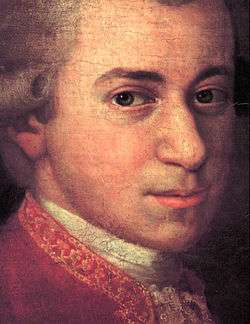Piano Concerto No. 9 (Mozart)

The Piano Concerto No. 9 Jenamy (Jeunehomme) in E-flat major, K. 271, by Wolfgang Amadeus Mozart was written in Salzburg in 1777, when Mozart was 21 years old.
Structure
The work is scored for solo piano, 2 oboes, 2 horns, and strings.
It consists of 3 movements:
- Allegro, in E-flat major and common (C) time, ~10:30
- Andantino, in C minor and 3/4 time, ~12:00
- Rondo (Presto), in E-flat major and cut time, ~10:00
The first movement opens, unusually for the time, with interventions by the soloist, anticipating Beethoven's Fourth and Fifth Concertos. As Girdlestone (1964) notes, its departures from convention do not end with this early solo entrance, but continue in the style of dialogue between piano and orchestra in the rest of the movement. Mozart wrote two cadenzas for this movement.
The second movement is written in the relative minor key. In only five of Mozart's piano concertos is the second movement in a minor key (K. 41, K. 271, K. 456, K. 482, and K. 488. K. 41 is an arrangement). Mozart wrote two cadenzas for this movement.
The third movement which opens with the solo piano is in a rondo form on a large scale. It is interrupted, surprisingly, by a slow minuet section (a procedure Mozart would repeat with his 22nd concerto, 1785, also in the key of E-flat). The work ends in the original tempo.
Reception
The work is highly regarded by critics. Charles Rosen has called it "perhaps the first unequivocal masterpiece [of the] classical style."[1] Alfred Brendel has called it "one of the greatest wonders of the world."[2] Alfred Einstein dubbed it "Mozart's Eroica."[3] Cuthbert Girdlestone was not quite as effusive in his praise, however, noting that the slow movement, while a great leap forward for Mozart, was still somewhat limited and the work as a whole was not equal to the piano concertos from the composer's peak in Vienna from 1784 to 1787, nor equal to his best compositions overall.[4]
Name
The work has long been known as the Jeunehomme Concerto. Théodore de Wyzéwa and Georges de Saint-Foix claimed that Mozart wrote the piece for a French pianist 'Jeunehomme' visiting Salzburg. This name is however incorrect; in 2004 Michael Lorenz demonstrated that the name was actually Victoire Jenamy (1749–1812), a daughter of Jean-Georges Noverre, a dancer who was one of Mozart's friends.[5] Mozart had made Victoire Jenamy's acquaintance during his stay in Vienna in 1773.
Notes
- ↑ Rosen 1997, 59
- ↑ "A Break From Romanticism With Some Mozart" by Vivien Schweitzer, The New York Times, 20 April 2012
- ↑ "Mozart Piano Concerto No. 9 in E-flat Major, K. 271" by Ethan Allred, Chamber Music Northwest
- ↑ Girdlestone (1964)
- ↑ Michael Lorenz, "»Mademoiselle Jeunehomme« Zur Lösung eines Mozart-Rätsels", Mozart Experiment Aufklärung, (Essays for the Mozart Exhibition 2006) Da Ponte Institut, Vienna 2006, pp. 423–29.
References
- Girdlestone, Cuthbert (1964) Mozart and his Piano Concertos. New York: Dover Publications. ("an unabridged and corrected republication of the second (1958) edition of the work first published in 1948 by Cassell & Company, Ltd., London, under the title Mozart's Piano Concertos." : Translation of Mozart et ses concertos pour piano.) ISBN 0-486-21271-8. Contains discussions with examples of the concertos from No. 5 in D major K. 175 to 27 in B-flat K. 595 (Nos. 1 to 4 being arrangements by the composer, also discussed though more briefly.)
- Rosen, Charles (1997) The Classical Style: Haydn, Mozart, Beethoven. Norton: New York. Rosen's discussion of the work appears on pp. 59–60.
External links
- Konzert in Es („Jeunehomme-Konzert“) KV 271: Score and critical report (German) in the Neue Mozart-Ausgabe
- Piano Concerto No. 9: Scores at the International Music Score Library Project
- Analysis, San Francisco Symphony
- Michael Lorenz: The Jenamy Concerto
- Michael Lorenz: Alfred Brendel's Final Program Note
- Michael Lorenz: The Continuing "Jeunehomme" Nonsense
